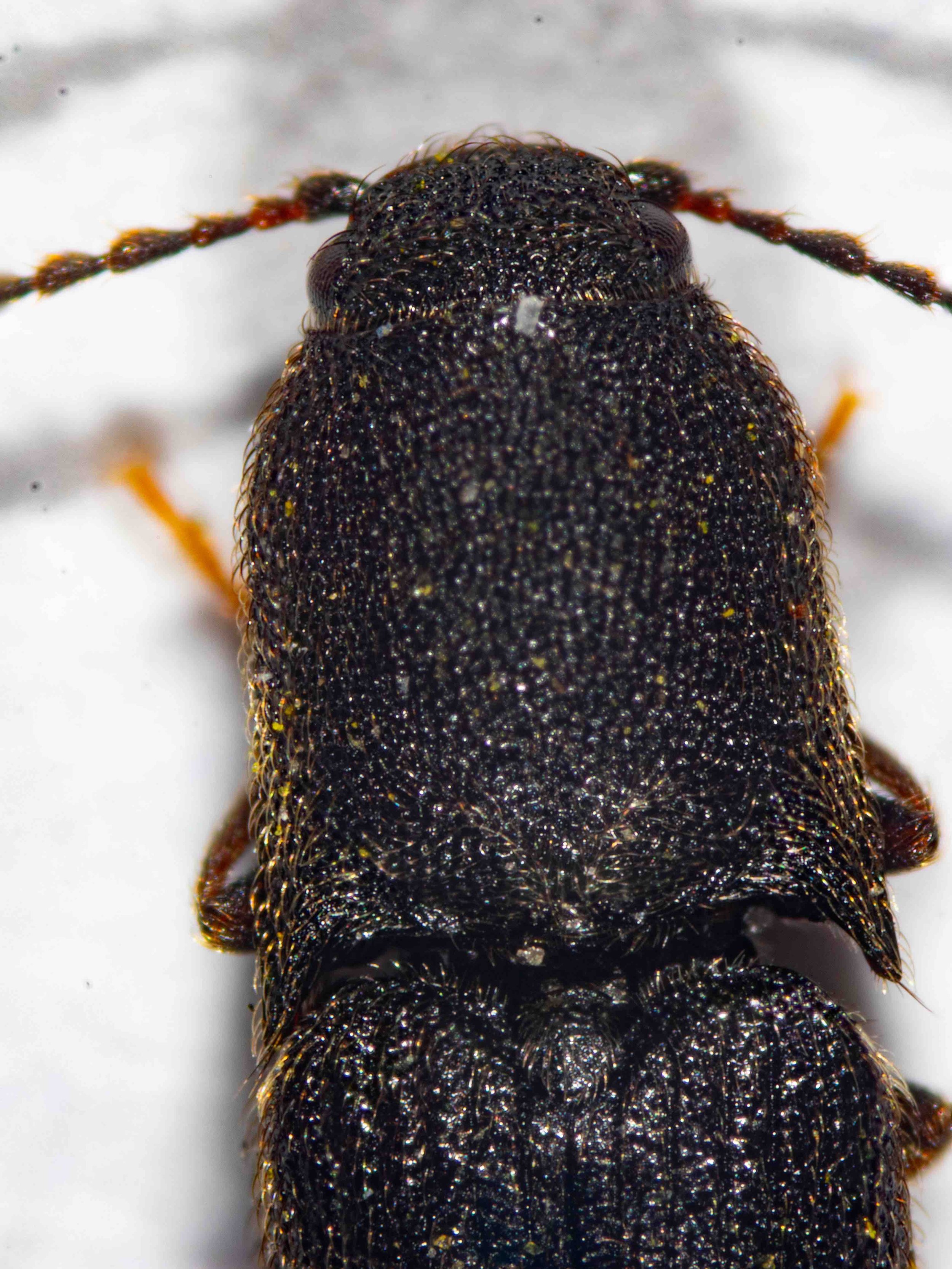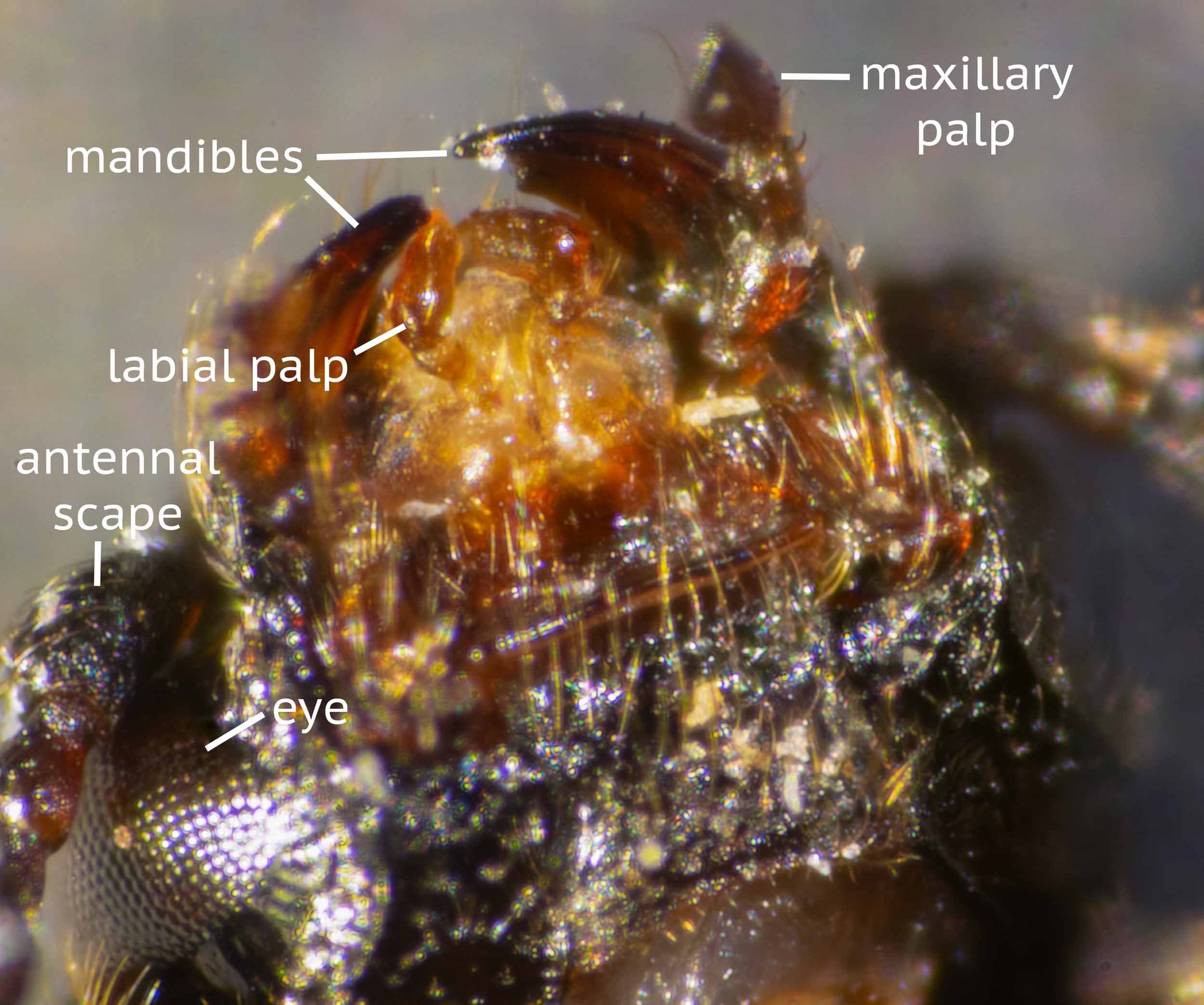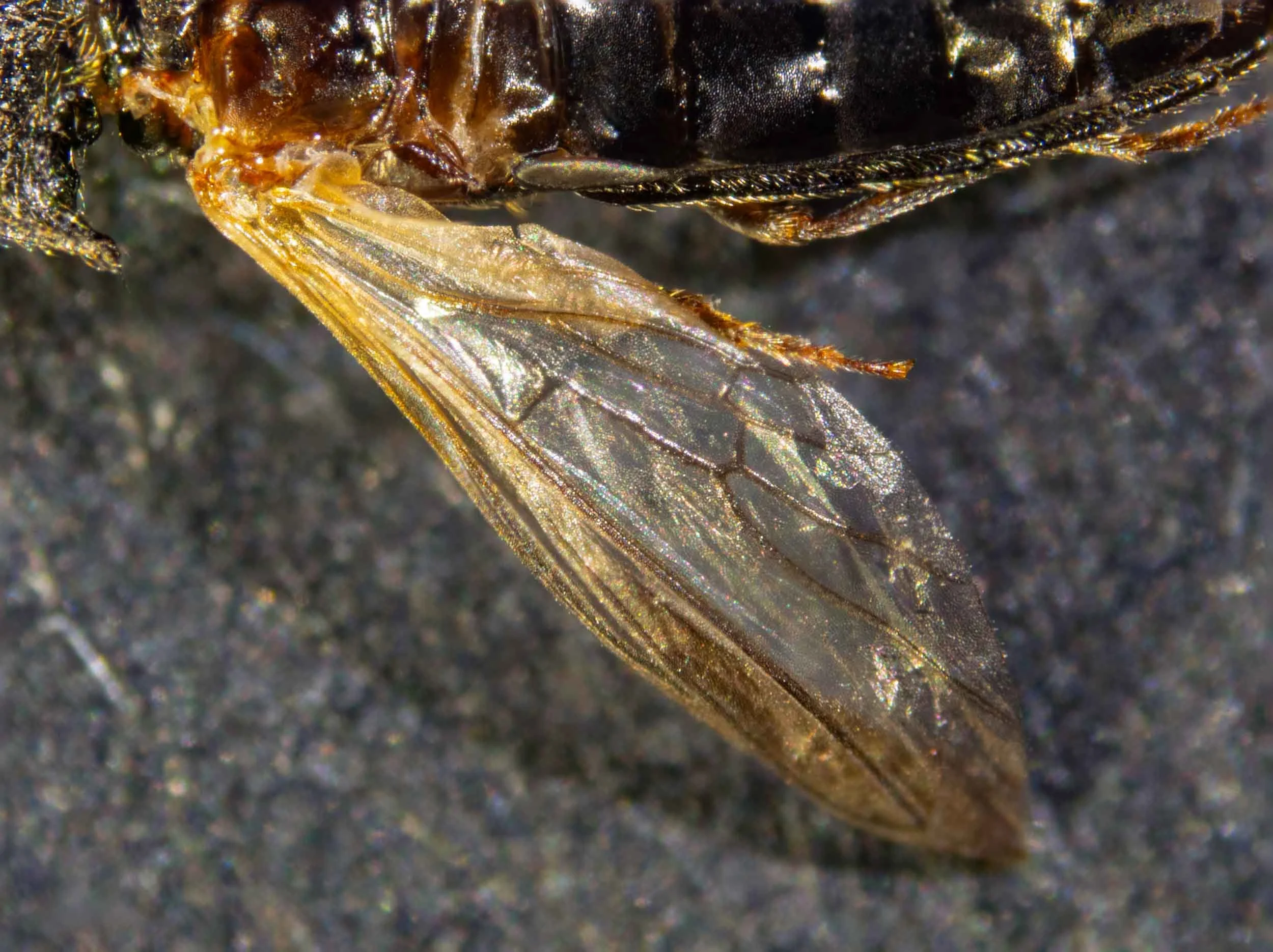Glyphochilus (Elateridae: Elaterinae)

Workbook
We captured this click beetle on 25th September as it was sitting on a low plant stem.
I used Andrew Calder’s “Genera of the Australian Elateridae” CSIRO Publishing 1996 to identify it.
fig. A habitus
Which subfamily?
Elaterinae - most likely
size range 4-31mm YES 6.3mm
head distinctly convex anteriorly YES
frontal carina usually complete across front between eyes (or incomplete medially) YES COMPLETE
antennae nearly always serrate or subserrate, rarely pectinate YES SUBSERRATE
prosternal spine (posterior to coxae) usually longer than procoxal diameter, rarely shorter or same length YES LONGER
mesocoxal cavity open to both mesepimeron and mesepisternum, rarely open to mesepimeron only (Anchastus, Diadysis, Melanotus) OPEN TO BOTH MESEPIMERON AND MESEPISTERNUM (unclear from photos but verified by following the key through to genera - see Additional Check below)
mesotrochantin visible, rarely not YES
hind wing with short radial cell; vein MP4 with apparent cross vein to CuA2, rarely without YES; YES
wedge cell present YES
apex of wing membrane (without venation) occupying less than 0.2 X length of wing membrane YES
apex with three sclerotisations arranged in form of Greek letter epsilon YES
tarsal claws without basal setae outer portion YES
Which genus in subfamily Elaterinae?
See this spreadsheet for features of the genera in subfamily Elaterinae and whether they match my beetle. It shows that the best match is to Glyphochilus. This genus matches 10 of the 11 diagnostic characters possessed by my beetle. All of the other genera fail on multiple characters.
The one character that does not match is elytra/pronotal length, which is 2.5 in my beetle and 3.3-3.8 in Glyphochilus.
Additional check using key in Calder 1996
(1) Tarsal claws without basal setae (vs. with stout basal setae arising from outer flat portion) –>(15)
(15) Mesocoxae open to both mesepimeron and mesepisternum –>(26)
Note: choosing other two options leads to clearly incorrect genera.
Choose “mesocoxa closed” –> (16) body clothed with setae (rather than scales) –> (17) tarsomeres simple, vertically or obliquely truncate distally, not expanded laterally vs. tarsomere 4 strongly expanded laterally
–> (18) Paracardiophorus or Patriciella - neither genus has apico-ventral membranous lamella on tarsomere 4 and each fails to match a number of other diagnostic features.
Choose “open to mesepimeron only” –> (19) pronotum without internal pockets for reception of antenna –> (22) tarsomeres simple, with spongiose pads or fleshy lobes on one or more tarsomeres or tarsomere 3 with elongate, setose lamella apico-ventrally –> Anchastus - this genus does not match 6 of the diagnostic features for my cricket
(26) “anterior margin of scutellum well defined, sharply angulate and steeply declivous to prescutum; labrum full exposed at base” –> (27)
vs. “margin not well defined, rounded, gradually sloping downwards to prescutum; labrum not exposed at base” - this option leads to genera Xuthelater, Parablax, Parasaphes, Tasmanelater and Wynarka, all of which fail on multiple characters including size and colouration (Xuthelater, Parasaphes, Wynarka, Tasmanelater) and presence of spongiose pads on tarsi (Parablax).
(27) “tarsomeres with lamellae on one or more lobes” (vs. simple or with spongiose pads) –> (55)
(55) “membranous lamella present on tarsomere 4 only (vs. present on tarsomeres 1,2, 3 and 4); mesocoxae separated by posterior margin of mesocoxal cavity (vs. mesocoxae subcontinuous); prosternum well developed anteriorly, produced forwards to form a ‘chin piece’” (vs. prosternum truncate anteriorly exposing labium) ….Glyphochilus
The other couplet at step 55 leads to Austrelater, which has pectinate antennae, ruling it out.
Glyphochilus description - from Calder 1996
(observations made on my beetle differing from Calder’s description indicated in bold italics)
body elongate, oblong, parallel-sided (fig. A)
3.3-3.8 X as long as wide (3.8 here)
more or less convex
clothed with setae, scales absent
vestiture semidecumbent, moderately dense, ashen-coloured and yellowish-white (coppery)
colouration: light or dark reddish-brown or black (black here)
integument: dull
length 6.8-10.6mm (6.3mm here), width 1.8mm here
Head:
more or less convex - fig. B, I, I’
frontal carina complete across front of frons - fig. H
frontoclypeal region gradually sloping to base of labrum - fig. H
eyes of male small, 0.2-0.3 X interocular distance (0.27 here) - fig. I, I’
mouthparts issuing from ventral surface of head capsule, directed antero-ventrally - fig. G, H
mandibles bidentate (with distinct second tooth medially on incisor edge)- fig. J, J’, K; apex narrow when viewed anteriorly
labrum fully exposed at base; semicircular, wider than long - fig. G, H, J
maxillary palp elongate, hatched-shaped; segment 3 shorter than segment 2 - fig. J, K, K’
labial palp hatchet-shaped; apex less strongly sclerotised than base - fig. K
antennae with 11 antennomeres - fig. L
antennae subserrate from antennomere 4; antennomere 3 longer than antennomere 2; antennomere 4 longer than antennomere 3 - fig. L
usually short, not reaching apex of hind angles of pronotum (as here) or rarely elongate, exceeding hind angles - fig. F, G, L, N
antennal insertions small, widely separated by greater than two diameters - fig. E, G
Prothorax
usually wider than long or rarely longer than wide (index: 84-105, here 103) - fig. O, 4.5mm long.
without median longitudinal depression - fig. O
anterior angles not strongly produced, only covering half of eye (at most, here only ~1/5) - fig. O
lateral margins of prothorax entirely carinate, carina extending from posterior to anterior angle - fig. P, P’
carina directed ventrally to lateral margin of prothorax anteriorly - fig. P’
base of pronotum without sublateral carinae or incisions, notched in front of scutellum - fig. R, S
hind angles of pronotum unicarinate, stout, moderately elongate, not divergent - fig. O, R, T
pronotosternal suture curved inwards; strongly marginate along hypomeral border; anterior portion of polished band along inner margin of hypomeron inclined meso-dorsally - fig. P, Q
prosternum without longitudinal carinae; narrowly marginate around procoxal cavities; well developed anteriorly, produced forwards to form ‘chin piece’ (this region slightly out of focus as it is directed ventrally) - fig. P, Q
prosternal spine inclined dorsad without ledge behind procoxae; with subapical tooth; without median longitudinal groove; portion of prosternal spine posterior to procoxae long (1.2-1.7 X coxal diameter, 1.8 here) - fig. U, V, V’, W
Mesosternum
scutellum tongue-shaped, apex broadly rounded, sides notched towards base; without longitudinal carina, anterior margin of scutellum well defined, sharply angulate and steeply declivous to prescutum - fig. O, P’, R, S, HH
mesocoxal cavity deep; floor with median shiny band extending length of cavity; sides straight, parallel-sided for greater part of their length, narrowing slightly between mesocoxae; sides steeply declivous, well-defined, reaching anterior margin of mesosternum; posterior margin of mesosternal cavity extending posteriorly 0.5 X coxal diameter - fig. U, U’, V
mesocoxae rounded, wide apart, separated by posterior margin of mesocoxal cavity (0.4 X coxal diameter, 0.5 here) - fig. V, W
mesocoxal cavity open to both mesepimeron and mesepisternum (fig. W)
mesosternum sloping anteriorly; margins around posterior edge of mesocoxal cavity prominently marginate - fig. W
exposed portion of metepisternum elongate to very elongate, 7.1-8 X as long as wide.
mesosternum and metasternum separated at midline by distinct external suture - fig. X
Elytra & Hind Wings
elytra 3.3-3.8 X pronotal length (2.8X here); 16mm long; striae impressed, strongly punctate-striate - fig. A, C, D, X’, Y
epipleura gradually narrowed at level of hind coxal plate; apex narrowly rounded - fig. D
hind wing length/width 2.4 (2.2 here)
wing membrane not notched in anal area - fig. Z’
radial cell present; short, 4.5-4.9 X (4.6 here) as long as wide; proximal, posterior angle more or less right - fig. Z’
horizontal radial cross vein (r3) extending from radial cell 0.13-0.16 X length of radius (0.10 here) - fig. Z’
radial vein not thickened apically - fig. Z’
vein MP4 with apparent cross vein to CuA2, branching from MP3 proximal to apparent crossvein between veins MP4 and CuA2 - fig. Z’
wedge cell present - fig. Z’
apex of wing membrane occupying 0.2 X length of wing membrane (~0.1 here) - fig. Z’, Z’’
with sclerotisations forming letter epsilon (wing torn and folded in this area but probably present) - fig. Z’
Legs
hind coxa moderately ascendant (no more than 20° to longitudinal axis of body) - fig. AA, angle between dashed blue line and midline = 20°
hind coxal plate with distal width less than half greatest proximal width nearest insertion of trochanter (0.2-0.3 X - 0.27 here) - fig. AA
outer posterior angle rounded; outer margin of hind coxal plate without elevated fold - fig. AA
hind coxal cavity open distally (rear wall of cavity visible) - fig. AA
mesotrochantin fully visible - fig. W
hind tibia subcylindrical, not compressed laterally, very slightly widened towards apex; with 2 short, subequal apical spurs; inner and outer margins with longitudinal rows of erect spiniform setae; hind tibia longer than hind femur; hind tarsus same length as hind tibia - fig. E, BB, CC
tarsomeres complex, with strongly developed membranous lamella present on tarsomere 4 only; not pilose ventrally; tarsomeres 1-3 with erect spiniform setae apico-ventrally - fig. DD, EE, FF
tarsomeres 1-4 decreasing in length distally; tarsomere 1 subequal to tarsomere 5, shorter than tarsomeres 2-4 combined; tarsomeres 2 and 3 combined longer than tarsomere 1; tarsomere 2 longer than tarsomere 3; tarsomere 4 shorter than tarsomere 3 - fig. DD, EE, FF
tarsal claws simple, without basal setae - fig. DD, EE, FF
Abdomen
Abdominal ventrites not strongly sclerotised, thin, pale in colour (dark here) - fig. P
Last visible abdominal sternite (ventrite 5) narrowed to either broadly or narrowly arcuate apex - fig. F
male: tergite 9 moderately strongly notched (U-shaped) medially; tergite 10 (anus attached ventrally) with posterior margin not as strongly sclerotised as medially
Male genitalia
aedeagus 2.2-2.4 X as long as wide (2.3 here) - fig. LL, MM
median lobe planar; apex exceeding or only slightly longer than apices of parameres - fig. NN
basal struts moderately long, 0.3-0.4 X total length of median lobe (0.35 here); apex narrowly rounded - fig. LL, OO
parameres articulated with median lobe; each with lateral subapical barb; apex partially membranous, setose - fig. LL, NN
base of parameres well developed ventrally, extending beyond dorsal base, not fused together medially - fig. LL, NN, OO
junction of basal piece and paramere transverse of slightly oblique (overlap of basal piece and paramere less than one-fourth length of paramere, 0.12 here) - fig. OO
basal piece 0.4 X total length of aedeagus (0.42 here), distinctly separate
photos above look similar but not identical to drawing of aedeagus of Glyphochilus leptus - fig. 338 in Calder, 1996.
my beetle
Glyphochilus inconspicuous from South Australian Museum has a similar overall morphology to my beetle.
Conclusion
My beetle is a close match to the description of genus Glyphochilus in Calder 1996 and differs in several morphological features from closely related genera. The only feature which differs significantly from Calder’s description is the elytra/pronotal length ratio, with my beetle having a relatively longer pronotum.
Glyphochilus has a widespread distribution over Australia and there are 16 described species.
Donald Hobern has Flickr images of a click beetle, which he identified as Glyphochilus sp. which has a similar elytra/pronotal length ratio to my beetle.
I conclude that my beetle is an undescribed Glyphochilus species.
This is a workbook page … a part of our website where we record the observations and references used in making species identifications. The notes will not necessarily be complete. They are a record for our own use, but we are happy to share this information with others.




















































